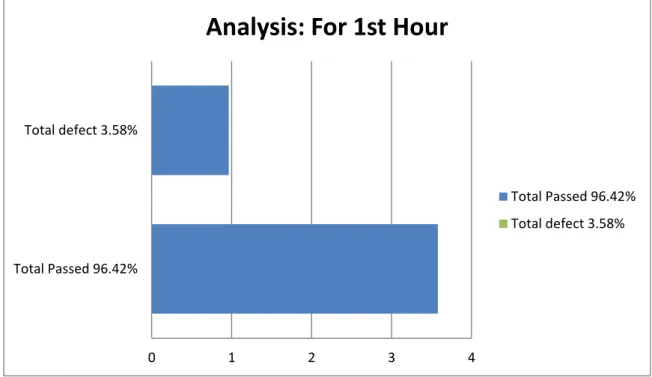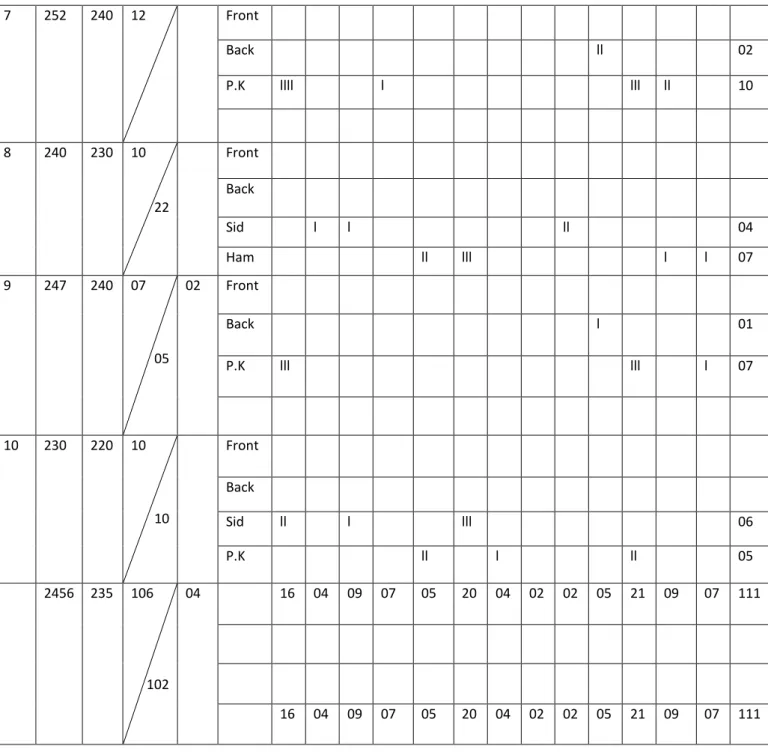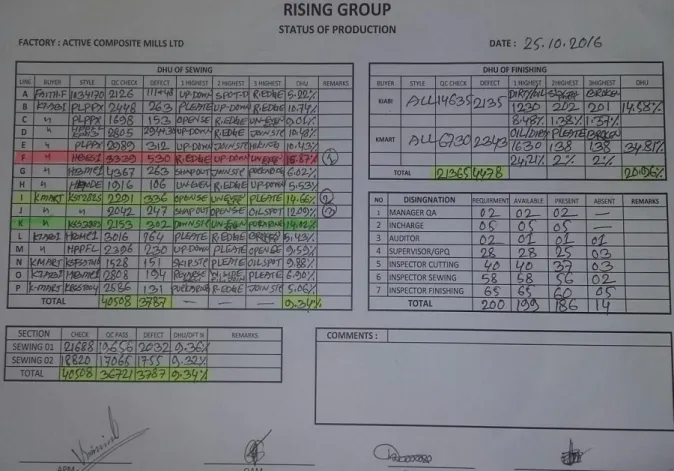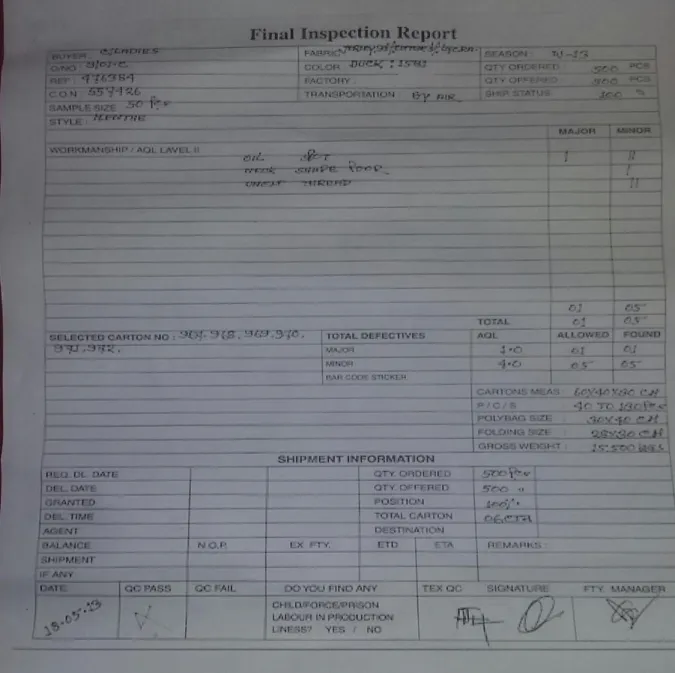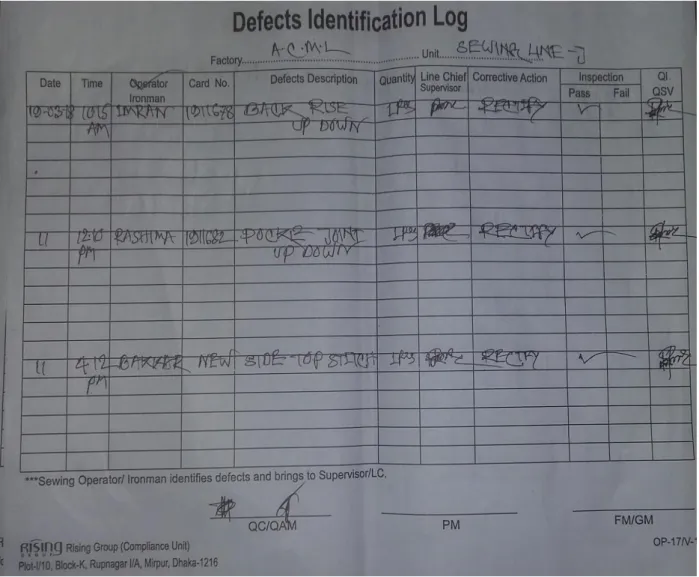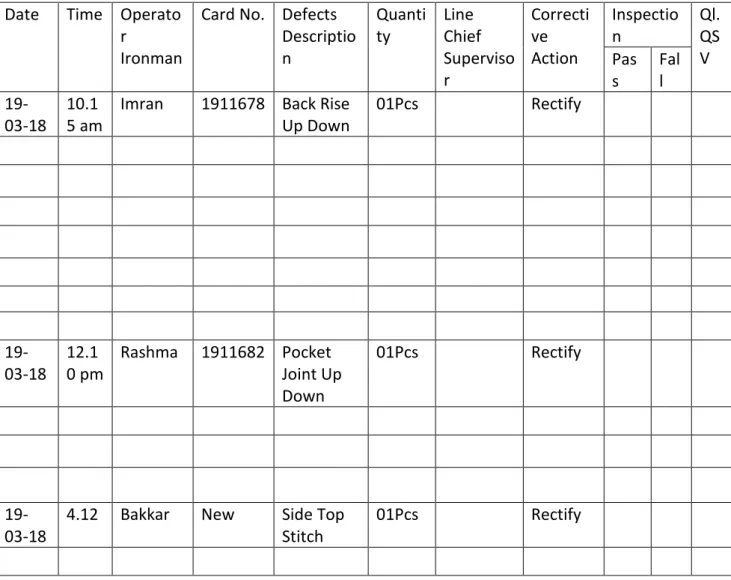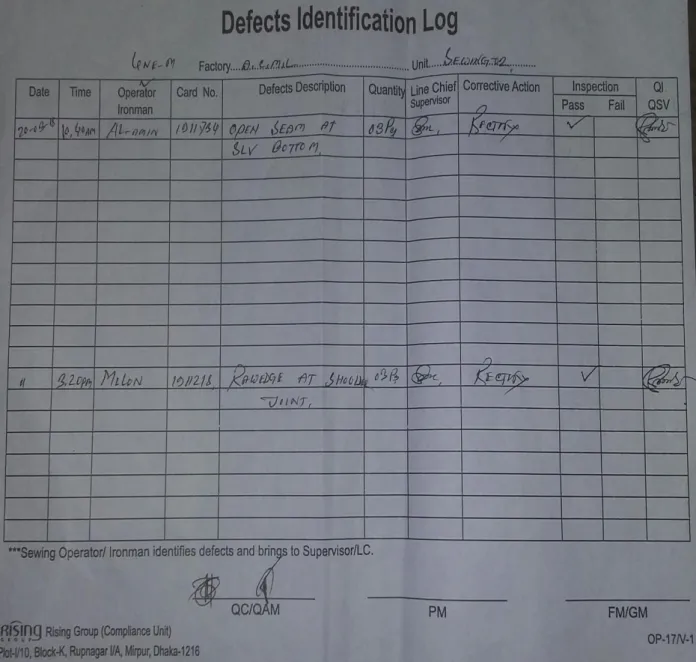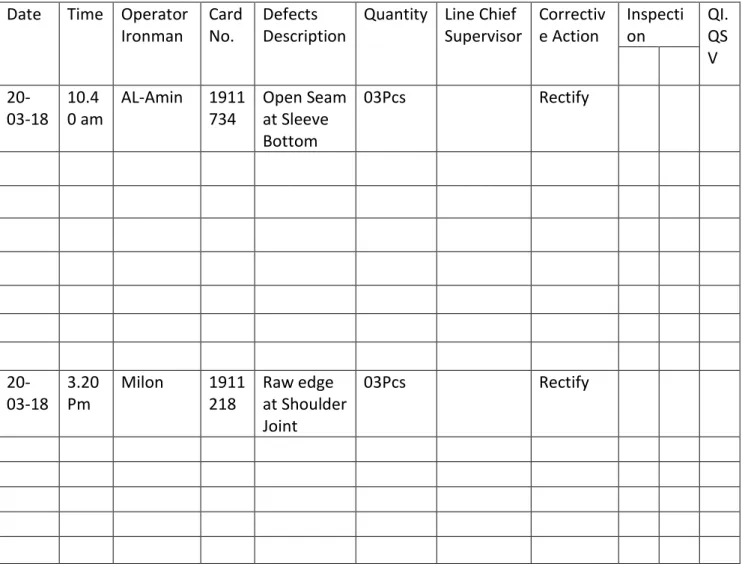We are just writing to let you know that this project report titled "Study on Clothing Inspection" was prepared by the students S.M. Therefore, it will be greatly appreciated if you will accept this project report and consider it for final evaluation. We would like to thank the people who have made a significant contribution to making this project possible.
Deep knowledge and keen interest of him helps and helps us a lot to carry out this project on Clothing Inspection. His endless patience, learned guidance, constant encouragement, energetic supervision, constructive criticism, valuable advice, checking very raw data and correcting it at all stages made it possible to complete this project. We would like to thank my entire course mate from Daffodil International University, who participated in effective discussion and suggestion to make this project as well.
We declare that, this project was done by us under the supervision of Engr. We also declare that neither this project nor any part of this project has been submitted elsewhere for awarding any degree.
Introduction
Background of Study
Objective of Study
Methodology
Limitation
Literature Review
Garments Inspection
Types of Inspection
It is done to cross-check for a safe control of mass texture and trim materials, styling of cut way, manufacturing of subtle elements and performing the garment or pre-generation test according to the customer's needs. This study is a follow-up to the first inline creation study and is mostly performed after the first line review, when errors have been identified around that time. Final random inspection: This inspection is performed when the production of the total quantity of an order or partial delivery is completed.
A sample piece will be selected from the request and a level of clothing items will be examined, this rate is largely determined by the buyer. After the embellishments are affirmed, all parts are checked against the evaluation specifications in the light of the direction sheet provided by the buyer side. Daffodil International University Page 8 Major Defects: A deformity that fails to meet the required controls directly affecting the comfort, attractiveness, welfare and valuation of the stock or as determined by the customer buyer are considered real imperfections and are mostly non-repairable for example texture gap, shading between boards, wrong grading, extraneous threads, color patches etc.
Minor defects: An imperfection that does not antagonistically affect the comfort of the item, but rather consists of a deviation from the first example, and can affect the offer of the item. Some of these imperfections are due to craftsmanship and some may be repairable, but at the same time may degrade the usability of the stock, for example, recoloring, jump line, wavy base finish and so on. When examining garments for cleanliness and fabric defects, the location of the defect and its effect on the appearance and performance of a garment must be considered.
Deformations that are noticeable on a piece of clothing but are not in the central territory of the garment shall not be a reason for rejecting the garment, as long as the execution, cut or external presentation of the garment is not impaired. Where the visual appearance of a piece of clothing is considered a MINOR zone of importance, but not primary. The individual wearing the piece of clothing or the viewer of it is not so noticeable at first glance.
Still, re-examining texture at the point of transport to the store on a garment's production line is critical. This system awards penalty points to each defect, depending on the duration of the defect. Daffodil International University Page 16 Under the ten-point system, a piece is judged "first" if the total number of penalty points does not exceed the total distance of the piece.
A checker is scored "second" if the total penalty points exceed the checker's total yardage. In this system, one should inspect at least 10 percent of the total rolls in the shipment and make sure to select at least one roll of each color. This happens due to wrong handling of the garment parts, wrong setting and timing between needle and bevel or hook etc.
This problem arises due to uneven alignment of fabric layers during sewing, improper thread tension, wrong choice of sewing thread, dimensional instability of fabric layers, etc.
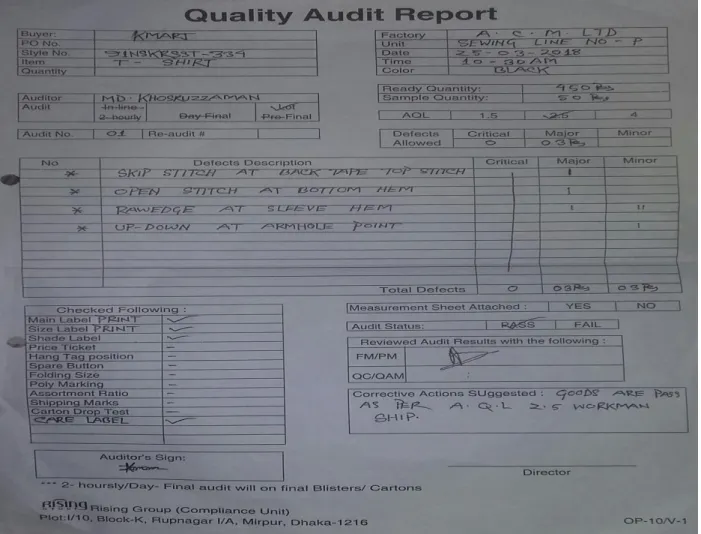
Flow Chart of garment Inspection
Inspection Procedure of Garments
- Confirmation of Quantity
- Confirmation of Accessories
- Size Spec Inspection
- In Side Inspection
- Out Side Inspection
- Final Inspection
- Packing
If the quantity does not agree with the packing list and written in the box, this discrepancy is communicated to the supplier. Subsequent stage is the confirmation of extras; here we confirm brand labels, bad brand labels, price labels or different labels, wash mind names, woven names or different names and embellishment as required by the buyer. If there is no chance that an estimation problem is seen, at that time we check the first example and educate the buyer at the same time.
At this stage, the garment is checked from the contact side to ensure that there are no textural defects, poor stitching, stains and so on in the garment. At this stage, the garment is checked from the outside to ensure that there is no variety of shadow, weaving deformation, texture imperfection, pressure deformation, openings, poor stitching, terrible stench, transmission of imperfection and stains and so on in the garment. Final inspection organization is the most vital part of the assessment process, here the garment is checked again to confirm that the examination is done correctly without missing any check, if any deformity is seen, we place it in the dismissal container or send it for reimbursement.
All "Review A" items are returned to poly bags as per initial bundling and then sent for needle examination. In this way, depending on the nature of the deformity, some garments are sent for repair and others are rejected.
AQL
- AQL Defects Classification……………………………………………………………………7-8
- AQL Chart
- Defects Classification –zones …………………………………………………………….9-10
Zero Tolerance covers the entire garment and applies to sharp questions or to synthetic items that pose a risk to the customer's well-being. For each situation, it will be the most authentic deformity experienced by the individual example under examination, with little respect shown for the trademark. For example, if a garment being assessed contains both a Major Deformity and a Minor Imperfection, the most extreme deformity (Major Imperfection) will be identified as the imperfection in the examination report.
So, it is fundamental to guarantee the quality of the texture before achieving the storage of garment processing factory items, generally the defective texture can bring trouble in generating and conveying the garment parts on time. Items of clothing created with defective texture can cause huge costs to the organization and can cause the generation of stock lots. The framework divides abandonments into major and minor compositions. The real defect is the one which is extremely visible and brings the products to the second quality.
The small deformation is the one, which could possibly have made the article of second wear, depending on its area of use finally. According to this framework, if any deformation was found in a complete article of clothing, the article of clothing would be designated as "moment". For textures, this frame characterizes a moment as "more than one imperfection for every ten straight yards, calculated to the nearest ten yards."
Daffodil International University Page 18 Total defect points per 100 square yards of fabric are calculated and acceptance criteria are normally not more than 40 penalty points.
Experimental Data in Line Inspection Certificate ……………………………….22-24
We completed this inspection report by following several steps and they are in line inspection, end line inspection, final inspection report. This is the first inspection in a series inspected by Active Composite Mills LTD. Measurement of clothes, sewing machine tension balance and sewing machine needle sharpness are checked by QC inspector.
Until then, the inspector calculates the total inspection quantity, defect quantity and defect percentage. Clothing measurement, sewing, machine tension balance, needle, sewing machine sharpness are checked by QC inspector. This is an hourly line inspection by Active Composite Mills LTD.
Until then, the inspector calculates the total amount of inspection, the amount of defect and the percentage of defect.
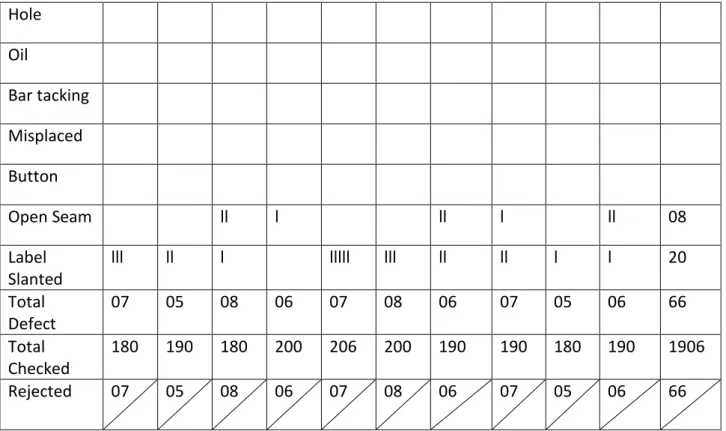
In Line Inspection from Data 3.1 And 3.2
End Line Inspection Report for Data 3.3
- Analysis Report from Data 3.3
- Graphical View 3 rd Line Inspection
After one hour finish line inspection, inspector inspects a total of 1698 pieces of garments and 1540 pieces of them are quality passed. After 2nd line finish line inspection, inspector inspects a total of 1916 pieces of garments and 1805 pieces of them are quality passed. After 8th hour finish line inspection, inspector inspects a total of 2153 pieces of garments and 1848 pieces of them are quality passed.
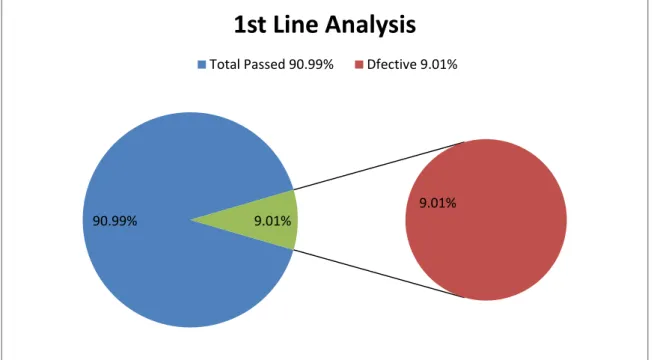
End Line Inspection Report for Data
- Analysis for Data 3.4
- Graphical View 4 th Hour Inspection
- After 8 th Hour analysis
- Some defects analysis from table
- Some defects analysis from table
After the 1st hour finish line inspection, the inspector inspects a total of 140 pieces of clothing, and 135 pieces of them are quality passed. After the 4th hour finish line inspection, the inspector inspects a total of 140 pieces of clothing, and 138 pieces of them are quality passed. After the 4th hour finish line inspection, the inspector inspects a total of 140 pieces of clothing, and 139 pieces of them are quality passed.
After Table 3.4 Analysis we found abnormal defect like Up-Down, Uneven Stitch and Sport. After Table 3.1 Analysis, we found that deviant defect such as up-down, raw edge, skipped stitch, open stitch not even and badge in silhouette. According to chart, defect is taken up and down 1 pcs, raw edge 3 pcs, Slan stitch 1 pcs, and open stitch 1 pcs.
This project helps us to know the inspection procedure not only that, but also to know about the different types of sewing and finishing errors and the method of correcting them. We also feel that this report helps us gather knowledge about the Sewing Section and Finishing Section of the Garment Industry. We can also know how the working procedure of this section and the inspection procedure of this section is done.
Finally, we can say that with the knowledge from this project that will help us in our professional life to accept the challenge in the hard work of textile engineer.
